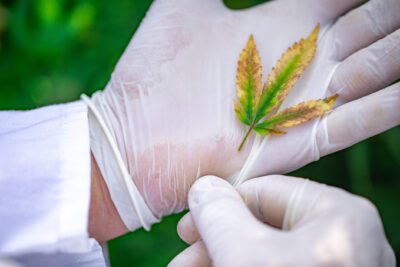Feeding your cannabis plants is core to the art of growing. Like any other plant and other life-forms, your cannabis plants need nourishment to thrive.
The cannabis plant is highly dependent on the essential macronutrients (potassium, phosphorous, and nitrogen), but they also need secondary macronutrients like calcium and magnesium to grow and yield healthy buds.
(This post contains affiliate links. If you buy through them I’ll get a commission at on extra cost to you. As an Amazon associate I earn from qualified purchases)
Calcium is essential in all stages of the plant’s growth because it makes its structure sturdy enough to support the buds. It also improves the plant’s resistance to fungi and bacteria and generally fortifies your plants against environmental attacks.
Table of Contents
CalMag Affects The Availability Of Other Nutrients To The Plant
Even before you think of the buds and how fat you like them, calcium helps in the absorption of other minerals that are essential to your plant’s growth.
If your plant is rich in calcium, the plant will exploit the grow medium for the other micronutrients.
However, calcium deficiency inhibits the absorption of other minerals, and thus, the plant can be marred by shortages even when you give supplements on the right schedule.
Magnesium is also another critical nutrient for your cannabis plants. Your plants need it throughout the growth stages as it is responsible for photosynthesis— which is how the plant makes the food that sustains it through the growth stages.
Magnesium also neutralizes acids in the grow medium and allows the plant to better utilize other nutrients for holistic growth and development. Like calcium, it also improves the plant’s resistance to fungus.
If you grow indoors under intense lights, you should supply your plants with enough magnesium to perk up the rate of photosynthesis. Supplementing magnesium also means the plant’s metabolism is at its peak, hence faster growth, better immunity, and healthier buds.
Magnesium deficiency will make your plant prone to diseases, stunt growth, and result in low-quality buds.
I wrote an in-depth article on how to remedy calcium and magnesium deficiencies in cannabis. It will help you diagnose your plants earlier and accord the right remedy.
Due to the risk of running low on these essential nutrients, most growers might give more than necessary. But does that pose any health threats to your cannabis plants?
Can You Overfeed CalMag?
Cannabis plants will be hurt when you overfeed them CalMag. Too much CalMag inhibits the absorption of other nutrients, leading to myriad deficiencies, unhealthy growth, and disease-prone plants.
However,Cannabis plants need lots of calcium and magnesium during growth, and so it is rare to overfeed CalMag in a well-balanced nutrient formulation.
To delve deeper into the effects of CalMag overdose, let’s look at the impact of individual nutrient toxicities in cannabis plants.
Calcium Toxicity In Cannabis Plants
Calcium, the essential nutrient for your cannabis plant, can pose various health risks when given in excess.
Calcium toxicity occurs when the plant gets more than it needs. The excess might be hard to diagnose because most growers are used to dealing with shortages than excess.
Early signs of calcium toxicity include wilting leaves, stunted growth, and nutrient burn on the leaves’ tips.
Calcium toxicity induces deficiencies in other nutrients like potassium, manganese, iron, and magnesium due to antagonistic effects. Too much calcium inhibits the absorption of these other nutrients.
Thus, it can be challenging to diagnose calcium toxicity in later stages as it will show up as a deficiency symptom of any of these nutrients.
Magnesium Toxicity In Cannabis Plants
According to Marijuana Horticulture Fundamentals, magnesium toxicity is extremely rare and is difficult to diagnose, and even when it occurs, visual symptoms may not occur.
But that doesn’t mean that magnesium toxicity should be ignored because an overdose can cause potassium or calcium lockout.
Signs of excess magnesium include curling leaves, dark and brown spots on leaves, and loss of old leaves.
Since magnesium toxicity causes calcium lockout, your plant will display signs of calcium deficiency when exposed to excess magnesium.
According to The Rev. True Living Organics, excess magnesium in the soil mix forms a hard layer on the top that makes it difficult for air and water to penetrate.
The hardening of the top layer of your soil mix makes your plant prone to root diseases as the much-needed oxygen is locked out.
Signs Of Too Much Cal-Mag
- Leaves wilting
- Curling leaves at the tips as happens with nutrient burn
- Dark or brown spots on both new leaves and old leaves
- Topsoil hardening into crust when you grow in a soil mix
- Poor growth and unhealthy development
- Poor root health, some roots may even die
RELATED READ: Should I Use Cal-Mag Every Watering?
How to Fix CalMag Overdose
Though CalMag overdose can maim your plants, it is pretty easy to deal with. When you realize before the damage is far-spread, you can tame it and rekindle the life of your plant— nurse it back to health.
Flush your plant with water (without additional nutrients) until the extra nutrient build-up has been washed away, then you can resume regular feeding.
Most growers only flush during the last weeks to harvest. However, leaving your plant in the grow medium with excess CalMag only worsens their growing conditions.
Still, it is crucial to balance the flushing act— only washing away the extra nutes while keeping the plant well-supplied. It would be catastrophic to move the plant from an excess CalMag situation right into deficiency.
You can be gentle about flushing. Instead of repeatedly flushing once, you can pace the flushing sessions. It is safer to flush with pure water after every ten days until the plant perks up.
This gives the plant enough time to adjust to nutrient fluctuations, as opposed to an immediate shocker.
Check The PPM Of The Water You Use To Water Your Cannabis Plants
Sometimes your plants suffer excess CalMag not because you feed them too much, but because you use the wrong water. Tap water is never really pure, and water hardness matters.
According to Marijuana Horticulture Fundamentals, hard water contains high amounts of calcium and magnesium and can lock out other minerals that the plant needs to thrive.
Water with over 50 PPM should be filtered so that it doesn’t add to the amount of CalMag you feed your plants. The recommended CalMag dosages are only correct when you’re using 0 ppm water.
Thus, you should test the PPM of your water to ensure it stays within safe limits. Controlling the PPM of your water is instrumental in keeping your plant safe from nutrient lockouts and deficiencies.
Can You Give Too Much CalMag In Coco?
It’s hard to give too much CalMag in coco because coco itself needs some calcium and magnesium to get buffered. The plant rarely gets more than it needs when the grow medium has taken its share of the CalMag supplement. However, you can still give more CalMag than you should, especially in later stages when the coco has been buffered.
The problem with CalMag is that it limits the dosage of other nutrients your plants need due to its impact on electrical conductivity (EC).
Thus, as much CalMag is widely harmless in coco, the other plant’s needs limit how much you can use.
As most growers will tell you, it is easier to suffer CalMag deficiency than to overdose in coco. So, giving too much CalMag shouldn’t scare you so much.
The plants are always waiting to gobble it up, and when the coco breaks down, it exposes its fibers with new surfaces to bind to the calcium and magnesium, stealing them from the plant’s share.
Also, coco is a neutral medium, unlike soil mix that comes with levels of naturally occurring minerals. Thus, when fed calcium, the plants utilize it quicker, reducing chances of nutrient toxicity.
The plants have no other source of these nutrients. They solely depend on the supplements, hence slim chances of nutrient overdose.
When you give your plants CalMag, the coco medium absorbs some of it, making it unavailable to plants.
Thus, growing in coco generally requires higher dosages of CalMag than growing in a soil mix.
Recommended CalMag Products
Last update on 2024-04-07 / Affiliate links / Images from Amazon Product Advertising API
Frequently Asked Questions About Overfeeding CalMag
CalMag can hurt your plants if given in excess because it inhibits their ability to utilize other nutrients. Overapplication of CalMag will result in unhealthy growth, nutrient burn, and ultimately low-quality buds.
The cannabis plant needs between 50 and 75 ppm of magnesium throughout its lifecycle to foster healthy growth and better yield. This range is higher than most crops but worth noting is that after 75 ppm, magnesium won’t improve your plant’s health and yield any further.
Autoflowers need calcium and magnesium, just like photoperiods. These nutrients are critical to the natural growth and development of cannabis plants— autos included. When autoflowers run low on CalMag, they exhibit the same symptoms as photoperiods—unhealthy growth, spotted leaves, weak stems, and poor bud development.
Do I Use Cal-Mag In Flowering?
During flowering, the cannabis plant needs lots of food to sustain it through the stage. Thus, adding CalMag in flowering improves the rate of photosynthesis which directly improves bud formation. In coco, it’s necessary to supplement CalMag throughout. In soil, it will depend on the amount of CalMag the soil holds. Either way, CalMag is safe in flowering.
CalMag goes first into the mix before base nutrients because calcium is double-charged and tends to bind to the phosphates and precipitate out of the solution, resulting in deficiencies. If you’re using silica blasts, let the silica go in first, follow with CalMag, then base nutrients. It is the only way to avoid CalMag deficiencies.
External Sources:
- K of Trichome Technologies. Marijuana Horticulture Fundamentals.
- The Rev. True Living Organics
- https://dutchmasternutrients.com/growers-guide/deficiency-toxicity/
- https://www.cannabisbusinesstimes.com/article/research-optimal-rates-for-magnesium-in-cannabis-cultivation/
- https://www.cocoforcannabis.com/needcalmag/





